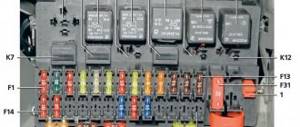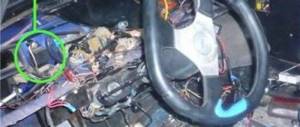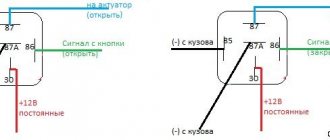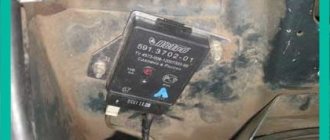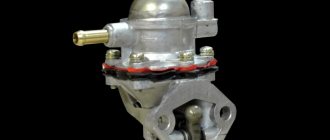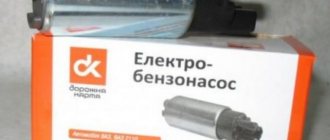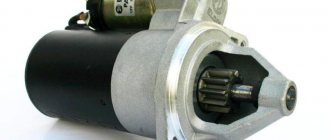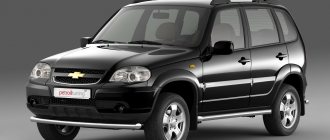Working principle of a car fuse
The components of automotive fuses are elements such as a body and a fuse link. Chevrolet and Daewoo Lanos vehicles are equipped with flag or plug-type devices. The body of such devices is made of plastic. The fuse link is located inside the housing, which does not necessarily have to be sealed. Two contacts (legs) protrude from the body, through which the part is installed in the electrical circuit of a certain device.
The most important parameter of a fuse is the amount of current it is designed for. All devices are designed to protect electrical wiring from fire, as well as prevent failure of electrical appliances. In simple terms, a fuse protects electrical equipment from short circuits and the flow of high current. High current can lead to melting and subsequent spontaneous combustion of the wiring.
The fuse link of the element is designed for a certain amount of current, which depends on the power of the pantograph (electrical equipment). As soon as the current in the circuit exceeds the rated value for which the fuse is designed, the fuse-link burns out. As a result, the circuit opens, thereby preventing melting of the wire insulation and failure of electrical appliances.
Once a fuse has tripped, it cannot be repaired and must be replaced with a similar current rating. It should be installed in place of the failed element only after the cause of the device’s operation has been identified. If, when replacing a failed fuse, you install a device with a lower or higher current strength, this will lead to the following situations:
- If the current is below the rated current, the device will trip when electrical appliances are turned on
- If the current is higher than the rated current, the fuse will not work, which will lead to melting of the insulation, as well as failure of the electrical appliance.
The rating of the protective element is indicated on the front side of the product. Additionally, manufacturers produce devices that vary in color. The color corresponds to the current strength for which the protective device is designed. Below is a table showing the device rating depending on color.
Using a table with colors is very convenient when the fuse rating is not visible. If you don’t know what rating a protective element should have in a circuit with a particular electrical appliance, then you shouldn’t guess. You can calculate it or use the information provided below.
Fuses installed in a 2008 Chevrolet Lanos
Below is the safety number and the rated current (A), and the circuit that is protected with this help is also indicated:
- 80A, F1 – electrical equipment of various types and purposes;
- 30A, F2 - equipment that operates electrically and is responsible for the operating state when the key is turned in one direction or another;
- 30A, F3 – operating electrical equipment when turning the key from the following positions: SNFRT, ACC, ON;
- 30A, F4 – engine cooling fan;
- 30A, F5 – electrically conductive windows;
- 30A, F7 – heated rear window;
- 30A, F8 – fan;
- 15A, F9 – fog lights located at the front;
- 15F, F10 – fuel pump;
- 20A, F14 – lighting outside the car;
- 20A, F16 – headlights and driving lights;
- 25A, F13 – front headlights;
- 10A, F17 – left low-beam headlight;
- 10A, F18 – low beam from the right headlight;
- 10A, F19 – stop signal, corrective electrical element of headlights, left lighting outside the vehicle;
- 10A, F20 – right external lighting, stop signal;
- P1 – audio playback signal;
- P2 – existing headlights;
- P6 – lighting outside the car;
- P9 – fuel type pump;
- P10 – rear heated glass.
See also: Which is better: Chevrolet Captiva or Mitsubishi Outlander
Where are the fuses on Chevrolet and Daewoo Lanos?
One of the main questions that all car owners ask is where the fuses are located. Before diagnosing the power circuit of a particular non-working electrical appliance, you should first find the required fuse. There are three places on Lanos where these devices are located. We will find out more about their location below.
Lanos have three fuse and relay blocks. Their locations are not known to all car owners, so we present information with photos:
- Block in the engine compartment. If you remove the cover of the unit, you will find the presence of not only protective devices, but also relays. This block is the main one, since this is where the devices responsible for protecting the ignition switch circuit are located
- Block in the cabin near the driver's feet. This block contains only fuses without relays. This block contains protective devices included in the circuit of interior electrical appliances - interior lighting, hazard warning lights, radio, ECU power supply, dimensions, etc.
- Relay box under the instrument panel. To gain access to it, you need to remove the decorative plug on the side of the dashboard or remove the panel of the headlight electric corrector unit. This unit is equipped with relay only
- An additional fuse is installed on the right side near the passenger's feet. It should be noted that this element was not installed on all Lanos cars, but only on those with an ABS anti-lock braking system. Its rating is 10A
- Additional relays are also installed under the hood of the car on the left side near the engine compartment
Knowing where the fuse and relay blocks are located on Chevrolet and Daewoo Lanos, you need to figure out which electrical appliances they are responsible for protecting and operating.
Chevrolet Lanos fuse diagram
The fuse diagram for the Chevrolet Lanos 1.5 can be located in the following places and elements of the car:
- in the engine compartment – control of the main engine;
- in the block (on the cover of the safety block);
- in the car interior;
- on the instrument panel - fog lights on the rear headlights, turn signal switches, windshield wipers, a fan in the general ventilation system.
Depending on the year of manufacture and equipment of the car, such a scheme may vary in different models. For example, the fuse diagram of a 2008 Chevrolet Lanos will differ from the diagram of the same car, but of a different year of manufacture.
Fuse and relay box under the hood on Lanos
This block is located on the right side when you open the hood. It is closed with a plastic lid, which ensures tightness. The lid is secured with latches. Under it there are not only fuses, but also relays. For easy removal of fuses, there is a special plug. Below in the photo is the digital designation of devices, the decoding of which is in the table.
Fuse element F1 protects the power supply circuit of fuses F1-F7 and F15-F20. F12 - used on cars with air conditioning. Protects the electrical clutch circuit of the air conditioner. F15 is an air conditioning compressor clutch relay diode. F19 - protects the power supply circuit of the brake light, electric headlight adjustment, exterior lighting on the left side, corrector illumination, clock, rear fog lights, ashtray lamp, radio and air conditioner illumination. F20 - additionally protects the power supply circuit for the right headlight and license plate lights.
In the table above, relay R3 is used on Lanos cars with air conditioning. This relay is responsible for the operation of the electrical clutch of the air conditioning compressor. R4 - this element may also not be used if there is one fan on Lanos, Sens or Chance. He is responsible for turning it on. R5 - turns on the front fog lights if the car has them. R11 - relay for turning on the cooling fans at first and second speed.
Chevrolet Lanos fuses and relays
Reviewed Chevrolet Lanos cars 1997, 1998, 1999, 2000, 2001, 2002, 2003, 2004, 2005, 2006, 2007, 2008, 2009, 2010, 2011, 2012, 2013, 2014, 2020, 20 20, 2020.
Where is the Chevrolet Lanos fuse box located?
The main fuse and relay box is located in the engine compartment.
To access the fuses and relays, remove the steam hose from the holder.
Then, pressing the two latches, remove the cover of the mounting block.
EF1-EF20 - fuses; K1-K6 - small size relay; K7-K11 - large relay; 1 - tweezers for removing small fuses and relays; 2 - jumper block
Purpose of fuses and relays Chevrolet Lanos
| EF1 | (80) | Fuse circuits EF15 - EF20 and F1 - F7 |
| EF2 | (30) | Ignition switch (power supply circuit for instrument cluster and fuel pump) |
| EF3 | (30) | Ignition switch (starter, heater fan, power windows) |
| EF4 | (30) | Electric motors of the main and additional fans |
| EF5 | (30) | Electric window motors for chevrolet lanos |
| EF6 | (50) | Not used |
| EF7 | (30) | Rear window heating element |
| EF8 | (30) | Heater fan motor (4th speed) |
| D9 (diode) | Air conditioning compressor electromagnetic clutch | |
| EF10 | (20) | Headlight bulbs (high beam) |
| EF11 | (YU) | Lamp for the left headlight (low beam), motor-reducer for adjusting the direction of the light beam of the left headlight |
| EF12 | (10) | Lamp for the right headlight (low beam), motor-reducer for adjusting the direction of the light beam of the right headlight |
| EF13 | (10) | Brake/side light lamp in the left rear light (side light), instrument cluster illumination, melodic signal, side light lamp in the left headlight, headlight beam adjustment switch, rear fog light switch, clock, hazard switch alarm, ashtray light, audio system, chevrolet lanos air conditioning switch |
| EF14 | (10) | Brake light/parking light in right rear light (side light), side light in right headlight, license plate lights |
| EF15 | (15) | Chevrolet Lanos fog lamps |
| EF16 | (15) | Fuel pump |
| EF17 (10) | Sound signal | |
| EF18 (10) | Air conditioning compressor electromagnetic clutch | |
| EF19 | (25) | Contact "30" headlight relay |
| EF20 | (20) | Contact “30” of the side light and interior lighting relay for Chevrolet Lanos |
Relay chevrolet lanos
| Number | Name | Switched circuits |
| K1 | Horn relay | Sound signal |
| K2 | Headlight relay | Headlight bulbs |
| short circuit | A/C compressor relay | Air conditioning compressor electromagnetic clutch |
| K4 | Additional fan motor relay | Additional cooling fan motor |
| K5 | Fog light relay | Fog lamps |
| K6 | Side light and interior lighting relay | Side light bulbs in the headlights, brake signal/side light bulbs in the rear lights (side light), instrument cluster backlight bulbs, interior courtesy lamp |
| K7 | Power window relay | Electric window motors for Chevrolet Lanos |
| K8 | Main Fan Motor Relay | Main cooling fan motor |
| K9 | Fuel pump relay | Fuel pump motor |
| K10 | Relay for rear window defogger chevrolet lanos | Rear window heating element |
| K11 | Cooling fan control relay | Relay for the electric motors of the main and additional cooling system fans |
Mounting block of relays and fuses in the interior of a Chevrolet Lanos
To access the fuses, press the cover latch and remove it.
On the inside of the cover there is a diagram of the location of the Chevrolet Lanos fuses.
The cigarette lighter fuse is number 10 (15A).
Decoding.
| Number | current, A | Protected elements |
| F1 | (10) | Trunk lamp, interior lamp, left rear fog lamp, antenna drive motor |
| Light switch in left steering column switch, lamp switch | ||
| F2 | (10) | fog light in the left rear lamp, headlight beam direction control, door open alarm |
| F3 | (15) | Alarm |
| F4 | (15) | central locking |
| F5 | (10) | Power supply circuits for the engine control unit from the battery |
| F6 | (10) | Audio system power supply circuit from battery |
| F7 | (15) | Brake/side light lamps in rear lights (brake lights) |
| D8 (diode) | Door Warning Switch (Driver's Door) | |
| F9 | (10) | Audio system power supply circuit from ignition switch |
| F10 | (15) | Chevy Lanos cigarette lighter fuse |
| F11 | (10) | Instruments and indicators in the instrument cluster (except for fog lights, direction indicators and door open) clock, glove compartment lamp |
| F12 | (10) | Reversing lamp in the right rear lamp |
| F13 | (15) | Airbag |
| F14 | (15) | Excitation of the generator, injectors, vehicle speed sensor, canister purge valve, exhaust gas recirculation valve, phase sensor |
| F15 | (15) | Chevy Lanos ignition coil |
| F16 | (15) | Direction indicator lamps in the headlights, direction indicator lamps in the rear lights, electric drive of the right outside rear view mirror |
| F17 | (15) | Power supply circuits of the engine control unit and fuel pump relay from the ignition switch |
| F18 | (20) | Windshield wiper motor, windshield washer pump motor |
| Coils of the rear window defroster relay, air conditioning compressor relay, | ||
| F19 | (10) | power window relay, relay (K4, K8, K11) of electric motors of cooling system fans |
| F20 | (20) | Heater fan motor (1st, 2nd and 3rd speeds) |
To access the relay inside the car, remove the cover with the headlight control (corrector).
1 - relay for direction indicators and hazard warning lights;
2 - relay for turning on the fog light lamp in the left rear lamp;
3 - intermittent windshield wiper relay;
4 - fourth speed relay for heater fan motor
Fuse box in the car interior on the left under the trim
The interior fuse box of Lanos, Sens and Chance is responsible for protecting various electrical equipment. There are 20 fuses located on this block in the passenger compartment. Let's look at their purpose in detail.
The table below provides not only a description of the purpose of each element, but also the maximum current value. When searching for or replacing cabin fuses on a Lanos, you must rely on the data from the table.
Fuse F2 is responsible for turning off the rear PTF lamps. It also protects the power supply circuit for the headlight range control and the door open alarm. F5 - protects the power supply circuit of the vehicle's ECU. The power cable comes directly from the battery. Fuse F8 on the block is responsible for supplying power to the light alarm on the driver's door. Element F13 is responsible for the proper operation of the airbags. F15 - supply voltage to the coil or ignition module. F20 - battery for the electric heater motor for speeds 1-3.
Breakdowns in a Chevrolet Lanos car
But a car, like other types of transport, can break down. Let's take a closer look at the breakdown of the fuel pump.
The moment we start the car, we always hear the sound of the fuel pump operating. Then it raises the pressure in the fuel rail, and the electrical unit turns it off. Then the fuel pump turns on automatically only when the engine rotates. When the crankshaft sensor begins to transmit pulses, voltage is applied to the coil, which is what helps supply voltage to the electric motor.
If you cannot hear the sound of a running fuel pump, then it is likely that the fuel pump in the Chevrolet Lanos is not working. In order to check yourself, you need to perform several steps.
- Raise the rear seat (passenger side).
- We see a hole in the flask, carefully remove it.
- Direct the hole with the contacts towards you.
- We connect a special tester to them. We start the car and check for voltage.
Relay block under the torpedo Lanos, Sens and Chance
Behind the control panel for the headlight range control of Lanos, Sens and Chance cars there are four relays responsible for the operation of the rear fog lights, direction indicators and hazard lights, heater fan and windshield wipers.
Under number “1” in the photo above there is a relay that is responsible for the operation of the electric heater motor, which is turned on at 4 speeds. If the stove stops working in position 4, then you need to check the serviceability of the relay. Number “2” is the device responsible for the operation of the car’s turn relay and hazard warning lights. Number “3” is the relay responsible for the operation of the windshield wiper, which operates in intermittent mode. Number “4” is the rear fog lamp relay on Lanos, Sense and Chance.
Separately, it should be noted that under the hood there are two more or one relay, which depends on the year of manufacture of the car. The devices are located on the left when the hood is opened near the engine shield. One element is responsible for sending a signal to start the engine, and the second is intended to control the operation of the generator. The relay supplies power to the generator integrated board.
This is interesting!
Short-circuiting relay contacts directly without using the device is strictly contraindicated. This will not only lead to the fuse tripping, but also the failure of electrical appliances.
What are fuses and what is their intended purpose?
Fuses are special elements installed on a vehicle that are responsible for the load of a particular system. They are necessary so that during the operation of the car, all its electronics are intact and do not burn out, which will render the four-wheeled friend inoperative.
The main function that a car fuse performs is to preserve the circuit of electrical connections from the occurrence of all kinds of short circuits. In the case of prolonged and significant voltage, the current indicators exceed the maximum value that was set by the developers at the time of invention. Under such a load, the device itself destroys several elements belonging to it, opening the circuit; in this case, there simply cannot be a closure physically.
See also: How much does a new Chevrolet Captiva cost?
What is a relay and its purpose on a car
An element such as a relay on a Lanos, Sense and Chance car is designed to close and open electrical circuits. In simple terms, these devices supply power to powerful electrical appliances through small buttons.
If you do not use a relay, and, for example, start the engine directly, then the contacts in the ignition switch will immediately burn out or the button will melt. This is due to the fact that when starting the engine, the starter consumes a very large current, which, when passing through the ignition switch contacts, would melt them.
To avoid making the on and off buttons massive, relays are used in cars. These are a kind of protective devices that divide the circuit into high-voltage and low-voltage. The devices have a simple design, and their main element is a coil with a winding. When using a relay, it is important to understand the purpose of its contacts:
- 85 and 86 - coil contacts
- 30 - common, which is supplied with constant power from the battery
- 87 - normally open contact or power supply to the receiver
- 87a - normally closed contact, which is also called additional
When replacing a relay, it is important to pay attention to which element was previously in the socket - three, four or five-pin. Replace only with a device of similar design.


